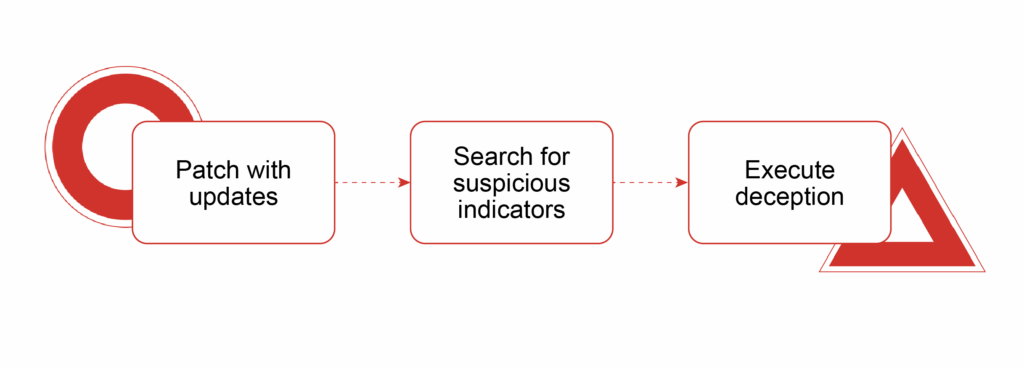On-premises SharePoint vulnerabilities anchored by CVE-2025-53770 are being actively exploited, putting identity, documents, and workflows at risk. Prioritize Microsoft’s updates, rotate machine keys, reduce internet exposure, and hunt using CISA indicators; then layer deception to turn first touch into actionable threat intelligence routed to your SIEM, XDR, and SOAR. The result is cleaner signals, faster detection and containment, and executive-ready proof of control effectiveness.
On July 20, 2025, CISA alerted defenders to active exploitation of on-premises SharePoint. The vulnerability chain includes a critical deserialization flaw. CISA urged immediate action and pointed to Microsoft guidance for rapid threat intelligence collection.
Within hours, CISA added CVE-2025-53770, nicknamed “ToolShell”, to its Known Exploited Vulnerabilities catalog. Patching and detection became business-critical priorities.
Microsoft’s security teams confirmed real-world exploitation by multiple China-based actors. Internet-facing SharePoint servers were being used for initial access, staging, and in some cases ransomware deployment. The exploitation targets on-premises SharePoint Server editions. SharePoint Online is not impacted.
CISA followed with a Malware Analysis Report. It published indicators and detections to accelerate hunting and containment.
Why this matters now:
SharePoint is a collaboration hub that touches identity, documents, and workflows. When adversaries land code execution on an on-premises SharePoint server, the path to persistence, credential access, and lateral movement can be very short with serious risk implications. Microsoft has advised customers to update supported on-prem editions, rotate machine keys, and verify exposure, while CISA has elevated CVE-2025-53770 to KEV, moving patching and detection to a business-critical priority.
How CVE-2025-53770 SharePoint Exploitation Works
CVE-2025-53770 is a critical remote code execution flaw in on-premises SharePoint Server. It’s caused by insecure deserialization. In the ToolShell chain, it pairs with authentication spoofing, path traversal, and code injection. Together, these let attackers land a web shell, pull secrets, and pivot inside your network with little to no friction. Microsoft and independent researchers confirm this is happening now against internet-exposed servers.
Microsoft released security updates and mitigations for supported on-prem editions. If you’re running SharePoint Subscription Edition, 2019, or 2016, patch and harden immediately. Then fold the IOCs and behaviors into your threat intelligence program for continuous monitoring.
However, patching doesn’t solve everything.
Two problems remain. First, exploitation attempts will keep hitting anything that looks like SharePoint on the public edge. Second, early telemetry in production is noisy and signature-driven. During a fast-moving event, reliable indicators are scarce.
You need a behavior-first signal that lands before the attacker gets a foothold. One your SOC can route to SIEM, XDR, and SOAR as actionable threat intelligence without delay.
Why Traditional Detection Struggles Here
Production SharePoint servers are noisy by design, with W3WP child processes, scheduled jobs, and integration traffic that can hide early adversary behavior. Web shells and living-off-the-land techniques often resemble legitimate administration, while signature feeds lag when exploit kits are still changing, so the first breadcrumb may not trigger prevention.
Leaders need high-confidence intelligence authored by the adversary themselves, specific enough to drive immediate, automated response. Deception delivers exactly that.
The Strategy: Patch, Hunt, and Trap
The fastest path to resilience is a three-step sequence. Each step builds on the last for active defense, turning a wide-open surface into controlled ground.
- Hygiene first. Apply Microsoft’s latest updates and mitigations for the affected on-prem editions. Validate exposure by inventorying internet-facing SharePoint services and reducing direct access where possible. Use CISA’s KEV to drive prioritization and report status to leadership.
- Hunting now. alerts are triggered by attacker actions rather than weak signatures.
- Low false positives: Search for web shells, suspicious child processes from IIS worker processes, unusual token use, and recent privilege changes tied to SharePoint service accounts. Leverage the indicators and detections CISA released to accelerate triage.
- Advance with deception. Surround your real estate with safe, instrumented targets that convert first touch into first signal with zero noise. This does not replace hygiene. It compresses time to clarity.
Execute these three moves in order and you turn a noisy, high-risk surface into a controlled preemptive cybersecurity ecosystem where clean alerts arrive early, threat intelligence is specific and actionable, and containment follows quickly.
Why CounterCraft for SharePoint Exploitation
CounterCraft’s approach stays out of the way of your business while pulling attackers into view by converting early interactions into high-fidelity threat intelligence. Digital twins sit alongside your environment with zero impact on production, which means no agents on real servers and no changes to live workflows. From there the focus is behavior, not signatures. Any probe, spoofed authentication, path traversal, or deserialization test against a SharePoint-style decoy becomes high-fidelity evidence that feeds your threat intelligence pipeline
Each event is enriched, mapped to MITRE ATT&CK, and routed into your SIEM, XDR, and SOAR so analysts get the context they need without a hunt that drags on. The result is faster containment through clear playbooks that can isolate a segment, revoke credentials, throttle a session, or tighten edge controls using clean, adversary-authored indicators. And you get proof you can show, with precision rate, mean time to detect, and reduced lateral movement measured and reported to executives and auditors as threat intelligence outcomes the board can track.
What this means for executives:
- Precision rate of deception alerts above 95 percent for SharePoint-specific events.
- Mean time to detect reduced from hours to minutes after first touch on SharePoint-like surfaces.
- Reduced lateral movement, evidenced by shorter or blocked attack paths in purple-team exercises.
- Containment time from first decoy hit to isolation of the source or segment.
- New, adversary-authored IOCs generated per quarter and reused across controls.
CounterCraft turns SharePoint exploitation from a noisy guessing game into clean, first-signal intelligence your team can act on in minutes. Every alert is real. Every interaction reveals intent. Investigations stay focused, uptime is preserved, and board updates move from speculation to evidence.
Ready to see this in your environment? Book a personalized demo and turn first touch into first signal.

